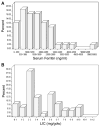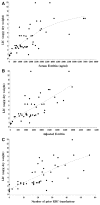Iron overload in patients with acute leukemia or MDS undergoing myeloablative stem cell transplantation
- PMID: 20854920
- PMCID: PMC3954514
- DOI: 10.1016/j.bbmt.2010.09.006
Iron overload in patients with acute leukemia or MDS undergoing myeloablative stem cell transplantation
Abstract
Patients with hematologic malignancies undergoing allogeneic stem cell transplantation (HSCT) commonly have an elevated serum ferritin prior to HSCT, which has been associated with increased mortality after transplantation. This has led to the suggestion that iron overload is common and deleterious in this patient population. However, the relationship between serum ferritin and parenchymal iron overload in such patients is unknown. We report a prospective study of 48 patients with acute leukemia (AL) or myelodysplastic syndromes (MDS) undergoing myeloablative HSCT, using magnetic resonance imaging (MRI) to estimate liver iron content (LIC) and cardiac iron. The median (and range) pre-HSCT value of serum ferritin was 1549 ng/mL (20-6989); serum hepcidin, 59 ng/mL (10-468); labile plasma iron, 0 LPI units (0.0-0.9). Eighty-five percent of patients had hepatic iron overload (HIO), and 42% had significant HIO (LIC ≥5.0 mg/gdw). Only 1 patient had cardiac iron overload. There was a strong correlation between pre-HSCT serum ferritin and estimated LIC (r = .75), which was mostly dependent on prior transfusion history. Serum hepcidin was appropriately elevated in patients with HIO. Labile plasma iron elevation was rare. A regression calibration analysis supported the hypothesis that elevated pre-HSCT LIC is significantly associated with inferior post-HSCT survival. These results contribute to our understanding of the prevalence, mechanism, and consequences of iron overload in HSCT.
Copyright © 2011 American Society for Blood and Marrow Transplantation. Published by Elsevier Inc. All rights reserved.
Figures


Similar articles
-
Retrospective Evaluation of Relationship Between Iron Overload and Transplantation Complications in Pediatric Patient Who Underwent Allogeneic Stem Cell Transplantation Due to Acute Leukemia and Myelodysplastic Syndrome.J Pediatr Hematol Oncol. 2020 Jul;42(5):e315-e320. doi: 10.1097/MPH.0000000000001829. J Pediatr Hematol Oncol. 2020. PMID: 32427707
-
Impact of pre-transplant serum ferritin on outcomes of patients with myelodysplastic syndromes or secondary acute myeloid leukaemia receiving reduced intensity conditioning allogeneic haematopoietic stem cell transplantation.Leuk Res. 2010 Jun;34(6):723-7. doi: 10.1016/j.leukres.2009.10.028. Epub 2009 Nov 26. Leuk Res. 2010. PMID: 19944463
-
MRI-based liver iron content predicts for nonrelapse mortality in MDS and AML patients undergoing allogeneic stem cell transplantation.Clin Cancer Res. 2012 Dec 1;18(23):6460-8. doi: 10.1158/1078-0432.CCR-12-1683. Epub 2012 Sep 18. Clin Cancer Res. 2012. PMID: 22991415
-
Clinical relevance of anemia and transfusion iron overload in myelodysplastic syndromes.Hematology Am Soc Hematol Educ Program. 2008:166-75. doi: 10.1182/asheducation-2008.1.166. Hematology Am Soc Hematol Educ Program. 2008. PMID: 19074076 Review.
-
Iron overload in myelodysplastic syndromes.Leuk Lymphoma. 2008 Mar;49(3):427-38. doi: 10.1080/10428190701843221. Leuk Lymphoma. 2008. PMID: 18297518 Review.
Cited by
-
Pre-transplantation iron chelation in patients with MDS or acute leukemia and iron overload undergoing myeloablative allo-SCT.Bone Marrow Transplant. 2013 Jan;48(1):146-7. doi: 10.1038/bmt.2012.94. Epub 2012 May 21. Bone Marrow Transplant. 2013. PMID: 22609885 Free PMC article. Clinical Trial. No abstract available.
-
Targeting ferroptosis for leukemia therapy: exploring novel strategies from its mechanisms and role in leukemia based on nanotechnology.Eur J Med Res. 2024 Apr 9;29(1):224. doi: 10.1186/s40001-024-01822-7. Eur J Med Res. 2024. PMID: 38594732 Free PMC article. Review.
-
Molecular Mechanisms of Ferroptosis and Updates of Ferroptosis Studies in Cancers and Leukemia.Cells. 2023 Apr 11;12(8):1128. doi: 10.3390/cells12081128. Cells. 2023. PMID: 37190037 Free PMC article. Review.
-
Comparative Study on Iron Content Detection by Energy Spectral CT and MRI in MDS Patients.Front Oncol. 2021 Mar 22;11:646946. doi: 10.3389/fonc.2021.646946. eCollection 2021. Front Oncol. 2021. PMID: 33828991 Free PMC article.
-
The Impact of Iron Overload in Patients with Acute Leukemia and Myelodysplastic Syndrome on Hepatic and Endocrine functions.Acta Biomed. 2018 Apr 3;89(3-S):18-22. doi: 10.23750/abm.v89i3-S.7213. Acta Biomed. 2018. PMID: 29633728 Free PMC article.
References
-
- Altes A, Remacha AF, Sureda A, et al. Iron overload might increase transplant-related mortality in haematopoietic stem cell transplantation. Bone Marrow Transplant. 2002;29:987–989. - PubMed
-
- Kataoka K, Nannya Y, Hangaishi A, et al. Influence of pretransplantation serum ferritin on nonrelapse mortality after myeloablative and nonmyeloablative allogeneic hematopoietic stem cell transplantation. Biol Blood Marrow Transplant. 2009;15:195–204. - PubMed
Publication types
MeSH terms
Substances
Grants and funding
LinkOut - more resources
Full Text Sources
Medical
Research Materials
Miscellaneous

